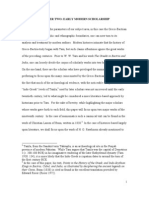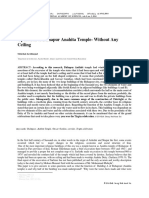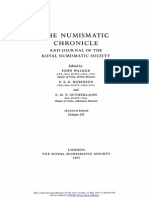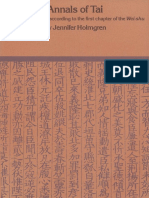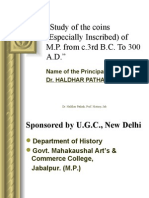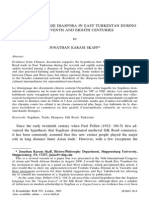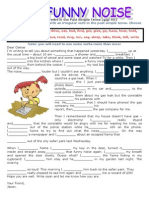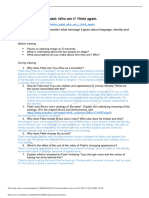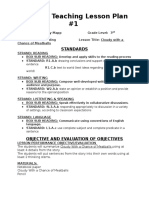Vol. 3. Silk Road. The Kushano-Sasanian Kingdom PDF
Vol. 3. Silk Road. The Kushano-Sasanian Kingdom PDF
Uploaded by
ketabxaarCopyright:
Available Formats
Vol. 3. Silk Road. The Kushano-Sasanian Kingdom PDF
Vol. 3. Silk Road. The Kushano-Sasanian Kingdom PDF
Uploaded by
ketabxaarOriginal Title
Copyright
Available Formats
Share this document
Did you find this document useful?
Is this content inappropriate?
Copyright:
Available Formats
Vol. 3. Silk Road. The Kushano-Sasanian Kingdom PDF
Vol. 3. Silk Road. The Kushano-Sasanian Kingdom PDF
Uploaded by
ketabxaarCopyright:
Available Formats
ISBN 978-92-3-103211-0
Contents
State organization and administration
4 THE KUSHANO-SASANIAN KINGDOM*
A. H. Dani and B. A. Litvinsky
Contents
State organization and administration . . . . . . . . . . . . . . . . . . . . . . . . . . Economy, society and trade . . . . . . . . . . . . . . . . . . . . . . . . . . . . . . . Religious life . . . . . . . . . . . . . . . . . . . . . . . . . . . . . . . . . . . . . . Cities, architecture, art and crafts . . . . . . . . . . . . . . . . . . . . . . . . . . . . Languages and scripts . . . . . . . . . . . . . . . . . . . . . . . . . . . . . . . . . . 107 112 113 115 121
In the early centuries of the Christian era the names of two great empires stand out boldly in the history of Central Asia. The rst was Kushanshahr, named after the Great Kushan emperors, who held sway from the Amu Darya (Oxus) valley to the Indus and at times as far as the Ganges. Here ourished the traditions of the Kushans, who had brought together the political, economic, social and religious currents of the time from the countries with which they had dealings (see Chapter 7). The second great empire (which rose to challenge Kushan power) was Eranshahr, which expanded both westward and eastward under the new Sasanian dynasty. Its eastern advance shook Kushan power to its foundation.
State organization and administration
According to Cassius Dio (LXXX, 4) and Herodian (VI, 2.2), Ardashir I (226 241), who waged many wars, intended to reconquer those lands which had originally belonged to the Persians. He defeated the Parthian kings and conquered Mesopotamia an event which led to his wars with the Romans. It is more difcult to judge his conquests in the east. According to the inscription of Shapur I (241271) at Naqsh-i Rustam, under the rule of
*
See Map 2.
107
Copyrights
ISBN 978-92-3-103211-0
Contents
State organization and administration
shahanshah [king of kings] Ardashir were Satarop, king of Abrenak (i.e. Abarshahr, or Nishapur, in Khurasan), as well as the kings of Merv, of the Sakas and of Kerman, all of whom were called Ardashir.1 But al-Tabaris information is different. He describes the conquest of Seistan (modern Sistan), Abarshahr, Merv, Balkh and Khwarizm up to the farthermost borders of countries of Khurasan. Then he writes that envoys of the Kushans, of Turan and of Makran came to Ardashir and offered their submission.2 Shapurs dominions in the east undoubtedly reached Merv and Seistan. To study the problem, Harmatta has used Greek, Latin and Armenian sources for the conquests of Ardashir I in the east against the background of all the wars that he waged; he has also taken into consideration the chronology of the Roman-Sasanian wars. His conclusions support al-Tabaris information. Ardashirs military activity in the west lasted from 224 to 232.3 Harmatta4 has rightly argued that after the conquest by Ardashir I, the western part of the former Kushan Empire became a vassal kingdom under the Sasanians, and subsequently a province governed by the Sasanian prince governors. These prince-governors issued coins as Kushanshahs (kings of the Kushans). At a later stage, the king of Kabul formed a marriage alliance with Hormizd II (303309). During the rule of Shapur I, Ardashirs son and heir, the power of the Sasanians in the east increased. This is demonstrated by the titles of Shapur I and the inscription on the Kac be of Zoroaster, according to which:
the state of Shapur I, shahanshah of Iran and non-Iran, included Vark an [modern Gurgan], Merv, Har ev [Herat], the whole of Abarshahr, Kerm an, Segist an [Sistan], Tur an [near Kalat in Baluchistan], Makur an [Makran], Parad an [near Quetta], Hindust an [Sind], Ku anahr up to Pukab ur [Peshawar] and up to the boundaries of Ka [Kashghar or Kesh], Sughd and a [Tashkent] (KZ, 2).5
The inscription text (Frye, 1984, p. 272). Earlier editions: Honigmann and Maricq, 1953; Sprengling, 1953. The rst author pointed out the difference in the titles of Ardashir I and Shapur I in 1979. Nldeke has expressed his opinion that information from other sources concerning Ardashirs conquests in the east (al-Tabari in particular) is much exaggerated (Nldeke, Tabari, 1973, S.1718). 2 Nldeke, Tabari, 1973, S.1718; Frye, 1984, p. 295. However, Nldeke and Frye suppose that most of the events took place during the rule of Ardashirs successor, Shapur I. 3 n According to Harmatta, the main target of Ardashirs eastern campaign was apparently the Kus .a .a Empire. The king made his campaign to the east in 233235 and the Sasanian invasion of Bactria occurred in 233 (Harmatta, 1965, pp. 18694). But Maricq believes that the eastern campaign took place at the beginning of Ardashirs I reign (Honigmann and Maricq, 1953, p. 106). We cannot establish the matter with certainty, but Harmattas interpretation seems the most convincing. 4 Harmatta, 1969, pp. 3868. 5 Some scholars (Lukonin, 1969a, pp. 2930; Zeimal, 1968, pp. 92100) doubt the reliability of the inscription concerning the description of the territory controlled by the Sasanians. In their opinion the enumeration of provinces was only a pretence, and these lands were not really included in the state of Shapur.
1
108
Copyrights
ISBN 978-92-3-103211-0
Contents
State organization and administration
Under Shapur I, the south-eastern provinces were united administratively and the country was called Sind, Segist an and Turist an as far as the sea shore. Narseh (293303), the son of Shapur I, was appointed ruler and he received the title of skn MLK (the king of the Sakas). The main dynastic line of the Great Kushans from Kanishka I had come to an end, but another line of Eastern Kushans continued to rule (see Chapter 7) in Gandhara and the Indus valley. On this interpretation, only the northern part of the Kushan Empire came under the direct rule of the Sasanian prince-governors. A great number of Kushano-Sasanian coins6 connected with the Sasanian domains in the east have been found in Pakistan, Afghanistan and Central Asia. They may be divided into three groups.7 The rst group was minted according to the model of the Kushan coins of Vasudeva. They are represented by both bronze and gold coins. On the obverse there is a gure of a standing king, each with a distinctive crown on his head and a legend consisting of the name and the title S ahano S aho (shahanshah) (Fig. 1) of the ruler. On the reverse there is a representation of Shiva and his vehicle, Nandi (the bull), with the legend, borzaoando iazado (the exalted deity) (Fig. 2). These coins were minted at Balkh and perhaps also at other centres (the mint name Bahlo for Balkh occurs on the obverse of some issues). The second group, also struck in bronze and gold, follow the Sasanian pattern. On the obverse they have a portrait of the ruler with his own individual crown (there are at least eight types of crown). On the reverse a re altar is represented. These coins were minted in Merv and Herat; the language of the inscription is Middle Persian, written in Pahlavi script. The third group consists of bronze coins that are much thicker and often of irregular shape. Their portraits are similar to those of the second group. The language of the inscription is Middle Persian, in Pahlavi script on some issues, in the Bactrian alphabet on others. Many of these coins have been found in Pakistan and it has been suggested that they were issued and circulated there. However, they have also been found to the north of the Hindu Kush and in Tajikistan.
However, other scholars (Harmatta, 1969, pp. 4209; Livshits, 1969, p. 56) consider that the inscription on the Kac be of Zoroaster is a reliable historical source and all these lands, including Kushanshahr, were included in the Sasanian Empire. 6 Cunningham, 1893; Bivar, 1956; 1979; Herzfeld, 1930; Lukonin, 1967; 1969a, pp. 3940; Cribb, 1981; Zeimal, 1983, pp. 25761; Gbl, 1984, pp. 7086; Trever and Lukonin, 1987, pp. 649; Harmatta, 1969, pp. 3857, 430; and others have contributed to their study. 7 Lukonin has suggested that the rst group should be called Sasanian-Kushan, the second KushanoSasanian and the third the Group of Kav adh (Lukonin, 1967).
109
Copyrights
ISBN 978-92-3-103211-0
Contents
State organization and administration
FIG. 1. Kushano-Sasanian coins (observe). Photo: Bibliothque Nationale de France.
On the basis of the coinage, the following list of the Kushano-Sasanian kings can be established:8 Ardashir I Kushanshah Ardashir II Kushanshah Peroz I Kushanshah
Some scholars have pointed out that the name of Hormizd on the coins corresponds to that of Hormizd II (302309), shahanshah of Iran. This provides a number of synchronisms while typological analysis has made it possible to identify the context of other coins. The concept was developed in detail by Herzfeld, 1930, and Bivar, 1979.
8
110
Copyrights
ISBN 978-92-3-103211-0
Contents
State organization and administration
FIG. 2. Kushano-Sasanian coins (reverse). Photo: Bibliothque Nationale de France.
Hormizd I Kushanshah Peroz II Kushanshah Hormizd II Kushanshah Varahran I Kushanshah Varahran II Kushanshah.
111
Copyrights
ISBN 978-92-3-103211-0
Contents
Economy, society and trade
However, Lukonin and his followers have advanced a number of serious arguments against this sequence and its chronology. His outline agrees with that of Gbl.9
Economy, society and trade
Several excavations undertaken in Kushanshahr provide ample material to reconstruct different aspects of contemporary life. The economic base may be inferred from the currency. Although gold and silver coins are known for several Kushano-Sasanian prince-governors, it is the copper coinage that was widely current to meet the local demands of the population. Herzfeld has shown that gold continued to circulate in international markets, as it did in the time of the Great Kushans.10 This must be due to the continuity of trade that followed the Silk Route as in the earlier period. The only change was that whereas the Kushans had earlier controlled this trade, it was now the Sasanians who, in spite of their wars with the Romans, were in charge of the principal ow of goods. Movements of the nomads in the east may have hampered the movement of caravans but the excavated materials suggest that goods were still freely exchanged from one country to another. The best evidence for such international trade contacts comes from Begram, Taxila and Dalverzin-tepe, where imported goods from several countries have been found together. As Ghirshman rightly remarks:
There was a transit trade in spices from China and Arabia, and nard and pepper were exported from India. International trade encouraged the growth of colonies of merchants, particularly Jews and Syrians, who established themselves as far aeld as India, Turkestan, Brittany and the Black Sea. The exporting houses became more specialized, and conned their dealings to cor, cattle, and manufactured goods.11
Another indication of the extent of international contacts is provided by the free movement of missionaries, Christians, Manichaeans and Buddhists, who travelled long distances from the eastern Sasanian provinces across Transcaucasia to Xinjiang along the frequented routes and promulgated their faiths. The social picture of Kushanshahr is extremely complicated because of the movements of several nomadic tribes into the territories ruled by the Kushano-Sasanian governors.
According to Lukonin, the conquest of the Kushan lands falls in the last decade of Shapur II (309379) and the investiture relief of Ardashir II (379383) at Taq-i Bustan represents the victory of the Sasanian shahanshah over the last Kushan king. Gbl comes to very similar conclusions but dates the beginning of the coinage to an earlier period 356 in his major work (1984). Other hypotheses refer the Kushano-Sasanian coinage to the fourth century. It is not possible to resolve the problem at present. However, the present author (Dani) supports Bivars system and chronology. 10 Herzfeld, 1930. 11 Ghirshman, 1954, pp. 3423.
9
112
Copyrights
ISBN 978-92-3-103211-0
Contents
Religious life
The picture will not be complete unless we start a little earlier and follow the process of migration until the coming of the Hephthalites.
Religious life
As the evidence of the coins clearly shows, the Zoroastrian faith, the traditional religion preserved in the province of Fars, enjoyed great popularity among the Kushano-Sasanians. Cults of Anahita and Ohrmazd ( Ahura Mazda) continued to occupy a prominent place in Fars after the Sasanians came to power. In both south-western Iran and the north-east there were great sanctuaries served by priests. The inuence of Zoroastrianism can be inferred from the representation of re altars on the coins. The most important sanctuary of re worship is that excavated at Surkh Kotal, which although originally built by the Kushan emperor Kanishka, was still in good repair during this period. The inuence of Zoroastrianism can also be seen in Gandhara sculpture where re worship is depicted; and re temples have been excavated at Kara-tepe. The Zoroastrian religion in Bactria must have been reinforced by the expansion of the Sasanian Empire. It was in this period that the cult of Mithra ourished. On the Kushano-Sasanian coins, we nd the Bactrian legend, borzaoando iazado (Middle Persian: bwldwndy yzty). Initially, this title was given to the Indian god Shiva but he soon received the nimbus with rays around his head like Mithra. Mithra was apparently regarded as a divine protector of the Kushano-Sasanian rulers and gave them their power.12 Ghirshman13 mentions an imperial religion, the need for which he sees in the rise of Shapur I. The Sasanian emperor needed to mobilize all his national forces for the struggle with Rome; hence the sympathetic interest shown by Shapur to the teachings of Mani (for Manichaeism, see Chapters 3 and 17). But the real patron of Mani was the young Peroz, by whom he was probably introduced to Shapur. Mani was of noble birth and like other prophets he claimed to have been sent by God to full the mission of earlier religions. He preached a universal religion and derived his doctrines from the cults of Babylonia and Iran and also from Buddhism and Christianity.14 According to Ghirshman, In the East, Buddhism [had been] at the height of [its] expansion since the time of the Kushans. In the West, centres of Christianity had sprung up in northern Mesopotamia and Judaism was active in Babylonia. Thus Zoroastrianism was squeezed by all these surrounding religions within its home province of Fars; and when Manichaeism challenged its position even here, there was a violent reaction. Mani was
12 13 14
Lukonin, 1987, p. 138. Ghirshman, 1954, pp. 30910. Lukonin, 1987, pp. 6970.
113
Copyrights
ISBN 978-92-3-103211-0
Contents
Religious life
tried, condemned and put to death. His followers were persecuted and ed abroad, some to the East, where their teachings ourished in Central Asia.15 How far was Zoroastrianism preserved in the Kushano-Sasanian kingdom? There is ample evidence to show the widespread popularity of the re cult and some scholars even maintain that the followers of Zoroastrianism persecuted Buddhists. Ohrmazd was still worshipped, however, and the dogmas, with their emphasis on a single divinity, were upheld. The m obads (high priests) accepted the traditions of south-western Iran, and along with them continued the worship of Anahita and Mithra, although they were given a secondary place. The old sacred traditions were put in writing in the form of the Avesta in the fourth century. Strengthened by its religious organization, Zoroastrianism was able to drive out Manichaeism and hold Christianity in check on the line of the Euphrates and Buddhism on the Helmand.16 Buddhist missionaries, on the other hand, continued to exert their inuence throughout the whole of Afghanistan and Central Asia. Their famous centres at Ghazni, Kabul, Bamiyan, Balkh and Termez maintained continuous contact with the centres in Gandhara, and central and East Turkestan. It seems very likely that Buddhism itself was undergoing a great change in its practices, ideological concepts and rituals. With the acceptance of the image of the Buddha and the expansion of Buddhism and Buddhist monasteries, the educational character of the sa ngha (Buddhist community) had taken on a new shape. The place of the Bodhisattvas and several other local deities had greatly increased. But Buddhism was not alone in this new expansion. The evidence of coins suggests that the popularity of Shiva and Nandi had caught the popular imagination. At the same time, the seated goddess Ardokhsho had begun to be identied either with Lakshmi or with Hariti, the queen of the yakshis. Other Hindu deities such as Karttikeya, Baladeva and Vasudeva were also prominent and the worship of the sun god remained important. Funerary practices such as corpse position and the burial of bones stripped of esh and soft tissue (which clearly refer to Bactrian Zoroastrian rites) provide important evidence for the religious beliefs of the local population. Burials took place in special structures (known as naus) as well as in ruins of old buildings. There were also burials in graves in the shape of pits. These are all a direct continuation of funerary rites of the Kushan period.17
15 16 17
Ghirshman, 1954, pp. 31418. Ibid., p. 318. Litvinsky and Sedov, 1984, pp. 75137.
114
Copyrights
ISBN 978-92-3-103211-0
Contents
Cities, architecture, art and crafts
Cities, architecture, art and crafts
Begram, Dalverzin-tepe, Kara-tepe and Surkh Kotal were among the principal foundations of the time of the Great Kushans. While Begram was the summer capital, Kara-tepe presents a group of caves, stupas and monasteries and Surkh Kotal preserved its character of a re temple (probably built by Kanishka). As the excavations showed, Begram was sacked by Shapur I in c. 244 but the city continued to exist afterwards and to play a role. The Buddhist complex of Karatepe was also deserted at some moment when the KushanoSasanians occupied it, but the discovery of Kushano-Sasanian coins and later construction provides evidence of its subsequent continuity as a religious centre. Similarly, Surkh Kotal preserved its character. Kara-tepe18 presents a typical model of cultural material that is syncretistic in nature. In original concept, the Buddhist caves and monasteries copy the type that is so well known in Gandhara. Staviskiy sums up: The Kara-Tepe excavations brought to light wall paintings, stone and stucco (ganch in local terminology), sculpture, terracottas, and pottery, metal ware and coins, inscriptions on pottery and grafti on the walls of the caves and their entrance niches. The structures constitute a complex of caves, a courtyard and some grand buildings. The ensemble is divided into four groups, A, B, C and D. Groups A and B originally formed a single complex with three courtyards, placed next to one another on a terrace along the eastern slope. In the northern courtyard, the remains of a stupa have come to light, while the central and southern courtyards were bordered with porticoes. South of the southern courtyard was a Buddhist temple, consisting of a cella surrounded by three corridors. The cave temples consisted of a cella and a vaulted corridor that encircled it. The walls in most surface and cave premises of groups A and B were painted over the plaster. A re altar stood in an attached niche with a shell-shaped back wall: the existence of a re altar in a Buddhist structure is most striking. It resembles those of the Kushan period found in Gyaur-kala in Khwarizm and Samarkand. Staviskiy remarks that altars of this kind were used by re worshippers, and in temples of the local Mazdean cults, and also in early Buddhist structures. They survived up to the period of the Arab conquest. Staviskiy notes:
After the complex B was destroyed or had fallen into abandonment, a re altar was built in the niche which had previously held a Buddhist statue. It was made hastily, out of materials that were at hand and symbolized the victory of some other cults (most likely Zoroastrianism) over Buddhism.19
18 19
Staviskiy, 1984, pp. 95135. Ibid., p. 114.
115
Copyrights
ISBN 978-92-3-103211-0
Contents
Cities, architecture, art and crafts
Part of the wall-painting shows a gure of the Buddha seated under a tree with three standing monks, close in execution to the Indian style. Here the Buddha has a halo around the body, probably of local Bactrian origin. Numerous stone and stucco fragments have been found which originally formed part of the decoration. Staviskiy concludes:
Stupas and cave premises (A and B complexes) were derived from India, along with Buddhism, whereas the planning of the cave temples is alien to the ancient Indian tradition and is rather to be traced to the religious architecture of the Middle East, where similar re temples could be found consisting of a cella and the corridors encircling it. As to the temple courtyards of Kara-tepe, they go back to the Rhodian type east Hellenistic courtyards that had become common in Bactria and the neighbouring Parthia already in thirdsecond centuries B.C.20
It may be noted that Buddhist temples of the type seen in Kara-tepe, particularly the planning and the representation of the Buddha with the nimbus and halo around the whole body, became common in East Turkestan and also in Eastern Asia during the post-Kushan period. Many other cities and settlements are known where life developed in the KushanoSasanian period on the territory of Bactria ( Tokharistan). At the Yavan site in southern Tajikistan, for example, a section of a small street was unearthed on the citadel. On each side there was a solid area of large house blocks with many rooms. These houses consisted of individual, interconnected premises. Walls were erected from pakhsa blocks (pakhsa is a local term for blocks of rammed clay mixed with nely chopped straw) and clay bricks. The structures probably had two storeys.21 The structures at the site of Halkajar, on the hills of southern Tajikistan, are similar to those at Yavan. A good collection of terracottas was made from here.22 Dalverzin-tepe, in the Surkhan Darya region (southern Uzbekistan), was a large city under the Kushans; but towards the end of the period, the main parts of the city and its fortications were neglected. However, buildings DT- 6 and DT-7 and the temple in the northern part of the city continued to function, as did the potters quarter with its kilns. The naus of Dalverzin continued to ll with funerary deposits, although burials were also found outside the naus. Kushano-Sasanian copper coins have been discovered at the site. Thus it is clear that the city continued to be inhabited in the traditional manner, although activity was not as intense as before.23
20 21 22 23
Staviskiy, 1984, p. 133. Zeimal, 1975, pp. 2679; Litvinsky, 1973, pp. 1417. Sedov, 1987, pp. 804. Pugachenkova et al., 1978.
116
Copyrights
ISBN 978-92-3-103211-0
Contents
Cities, architecture, art and crafts
Zar-tepe, another large city in the Surkhan Darya region, is of considerable interest. Its heyday was in the Kushan period, but subsequently its fortications fell into disrepair. In the centre of the city stood a palace-type complex with two halls: one was four-columned (139.3 m); the other was twelve-columned (17.69.2 m), with an aiw an (hall) in front. During the last period, brick pedestal-supports for a re altar were constructed between the columns. The halls adjoined other rooms where fragments of painted clay sculptures have been found. Zar-tepe had a Buddhist shrine, a large structure decorated with clay sculptures of which one head is preserved. Buddhism was not the only religion of the urban population, however. A number of residential districts have been excavated. Blocks of adjoining houses were discovered on both sides of the street, each block consisting of 811 interconnected buildings. Every block was separated from its neighbour by a narrow street at right angles to the main road. In one of the house blocks a shrine was also found with, in its centre, a re altar standing on a square platform. Similar shrines have been found at other sites. Here again, Kushano-Sasanian coins were discovered in the upper level.24 Kay Kobad Shah, the ancient capital of the Kobadian district, continued to exist under the Kushano-Sasanians, its fth and last period of existence being separated from the previous occupation by a sterile layer.25 Alongside the large cities a great number of villages and other settlements existed. In addition, cult buildings, burial monuments and other constructions have also been excavated. Even in the small Kobadian oasis many Kushano-Sasanian archaeological complexes have been recorded, in particular at the sites of Kay Kobad Shah, Ak-tepe II, Darakhsha-tepe, Klych-duval, Shodmon-kala and Munchaktepe, where sanctuaries, burials, remains of irrigation works and other structures have been found.26 Among cult buildings, mention should be made of the monastery of Ushtur-Mulla, near the Amu Darya river. The monastery consisted of 26 buildings which surrounded a square courtyard. In the middle of the north side was a shrine with a -shaped circumbulatory corridor. There were small residential cells for individual monks and a large hall for sa ngha (congregational) meetings. The shrine was decorated with paintings and alabaster sculptures. Outside the complex was a stupa, the base of which was faced with stone reliefs.27 Another site of this period is Chaqalaq-tepe, in northern Afghanistan, which had an oval plan and was surrounded by two circles of city walls made of pakhsa. Its two lowest layers were dated by coins to the Kushan period. The 307 coins in the upper levels included 72
24 25 26 27
Masson, 1976; Zavyalov, 1979. Dyakonov, 1953, pp. 276, 289. Sedov, 1987, pp. 1148. Zeimal, 1987.
117
Copyrights
ISBN 978-92-3-103211-0
Contents
Cities, architecture, art and crafts
imitations of coins of Vasudeva and a coin of the Sasanian Kushanshah, Varahran II.28 Village sites have also been excavated, such as Durman-tepe, where two small hoards of Kushano-Sasanian coins were discovered.29 So, during the Kushano-Sasanian period life continued in the cities and villages to the north (that is to say, in right-bank Bactria) and south of the Amu Darya. The number of sites in both northern and southern Bactria with settlements of the Kushano-Sasanian period is extremely large;30 there were also some in central Afghanistan, particularly in the Kabul region. Two Buddhist monasteries have been discovered at Tepe Maranjan (Kabul), in one of which a hoard of 326 silver Sasanian coins and 12 gold Kushano-Sasanian coins was found.31 Some of the architectural features of the period have been mentioned above. There were established categories of architectural structure: palaces, common residential quarters and various types of cult buildings, including Buddhist monasteries both in caves and on the ground. There were also buildings serving technical functions such as water-reservoirs and workshops. Monumental structures and ordinary everyday buildings existed side by side. They differed greatly in the quality of their construction. Pakhsa, especially for wall foundations, and square mud-bricks were the most common materials; baked bricks and stone were used more rarely, mainly for paving and for the pedestals of column-bases. Roofs were usually at, and in small buildings the beams rested across the tops of the walls. In large buildings, however, columns were also used. Vaults and domes were known. For the transition from the square ground plan to the circular dome, squinches were adopted. All kinds of passages and niches had arches. The wall surface was covered with one or more layers of plaster. The interiors both of monumental secular buildings and of cult buildings were decorated with wall-paintings and sculpture. There were two trends in the art of the time: Buddhist art developed from traditions going back to the art of Gandhara with local features, whereas non-Buddhist art displayed a complex fusion of local and Sasanian traditions. This latter feature is well seen in the sculptures and wall-paintings from Dilberjin.32 Especially interesting are the wallpaintings from structure 12 of the northeast cult complex. The largest fragment represents a gure on a yellow throne, sitting frontally with knees apart. This pose is typical of representations of Sasanian kings and gods enthroned. The arms also are kept apart and there is an object, possibly a mirror, in one hand. The left hand is resting upon a shield. The gure
28 29 30 31 32
Mizuno (ed.), 1970. Mizuno (ed.), 1968. Sedov, 1987, pp. 1148, 7895; Ball and Gardin, 1982, especially p. 483, Map 67. Curiel, 1953; Hackin, 1953; Fussman and Le Berre, 1976, pp. 959. Kruglikova, 1976, pp. 96100, Figs. 568.
118
Copyrights
ISBN 978-92-3-103211-0
Contents
Cities, architecture, art and crafts
is dressed in a loose shirt and there is a belt around the waist. A cloak is thrown over the shoulders and there is a golden helmet on the head. Black plaits hang beneath the helmet and the head is surrounded by a yellow nimbus. (The presence of the nimbus indicates that the gure represents a deity.) Two yellow horn-shaped objects project from behind the shoulders. On each side there are two standing personages turning towards the deity and a number of smaller gures. The outermost personage of the right-hand group is only half as large as the other standing gures. The contours are traced with a thin black line. The painter understood the application of light and shade, and although frontal representation is a dominant feature of this style, prole gures are slightly inclined to the front. This painting is a fusion of several traditions. The form of the helmet reects that of Antiquity. There are strong connections with the subsequent paintings in Tokharistan at Balalyk-tepe and Kala-i Karnigan. This provides clear evidence that a local Bactrian art existed and was developed in Bactria during Kushano-Sasanian times, although it absorbed other traditions and was powerfully inuenced by ofcial Sasanian art. Fine specimens of metal-working of the Kushano-Sasanian period are known. In Sasanian toreutics, Lukonin has singled out an East Iranian School which he ascribes to masters at the court of the Kushanshahs. Among works of this school he lists ve silver dishes, upon each of which an equestrian hunt is represented. The dish in the Hermitage Museum is remarkable (Fig. 3). It depicts a rider, hunting wild boar. One beast has already been struck by the riders sword, the other is emerging from the undergrowth. On the riders head there is a crown with spiral horns. The crown resembles in general terms that of Varahran II Kushanshah. The surface of the images is gilded and there is a Sogdian inscription of the fthsixth centuries on the dish, providing an upper limit for the date. Lukonin concludes that Kushano-Sasanian metal-work follows the general trends of Sasanian art, particularly in the choice of subjects such as heroic hunting scenes, but the composition differs in exercising more freedom.33 The orientation of Kushano-Sasanian metal-work towards Sasanian art can be explained by its court character. The minor arts are mostly represented by terracotta gurines. Only occasional examples follow the traditions of Sasanian art, especially those of Sasanian portraiture. Bactrian features emerge in the foreground in this rather popular art. Craft industry, especially pottery, was highly developed. There are examples of table-services, storage jars and kitchen ware. Some types were developed from those used in Kushan times, but new types continued to emerge. The ornament of vessels changed, and became more concentrated towards the top of the vessel.
33
Trever and Lukonin, 1987, pp. 6173, 108, Pl. 14 (7), 15 (7).
119
Copyrights
ISBN 978-92-3-103211-0
Contents
Cities, architecture, art and crafts
FIG. 3. Silver dish. Photo: Terebenin (Hermitage, St. Petersburg).
Everyday utensils, ritual objects, mirrors of several types, buckles and ornaments were made of bronze. Tools and weapons were made of iron. Pins, combs and similar items were made of bone and there were beads, and vessels made of glass. A large quantity of jewellery was inlaid with a variety of precious stones. Armourers produced composite bows, arrowheads, daggers, swords, lances and plates of armour. The shape of certain types of weapon changed, especially the triangular arrowheads, which developed a groove behind the point.34
34
For details, see Sedov, 1987.
120
Copyrights
ISBN 978-92-3-103211-0
Contents
Languages and scripts
Languages and scripts
It is only possible to judge the language of the Bactrians in ancient times by personal names. The situation changes, however, in the rst centuries a.d. The discovery of the inscriptions at Surkh Kotal, and then other inscriptions, especially in Central Asia, has allowed scholars35 to determine the peculiarities of the Bactrian language. It belongs to the group of East Iranian languages, more precisely to the north-eastern group. There is a marked similarity with the modern Munji language, which is probably a continuation of one of the Bactrian dialects. Bactrian represents the Middle Iranian stage. Written Bactrian used an adaptation of the Greek alphabet, with an additional 25th letter, san, which reproduced the sound s. The Greek writing reproduced the Bactrian phonetics only approximately, although certain methods of Greek orthography were transferred into Bactrian and Greek scribes apparently took part in creating the Bactrian writingsystem. Initially its letters were of lapidary or monumental style, but later a cursive form was developed. In spite of the Sasanian conquest, Bactrian scribes continued to work in Balkh and other centres. By the third century the transition from a lapidary to a cursive style was completed. Round-shaped letters and the presence of ligatures are characteristics of the cursive style. Kushano-Sasanian coin legends, as well as the inscriptions on wallpaintings from Dilberjin, are of this type. Some of them can be referred to the thirdfourth centuries. The inscriptions include explanations of the content of the paintings.36 In the state of the Kushanshahs, apart from high ofcials and military personnel, there were inevitably natives of Iran, including both scribes and marginally literate persons. It is quite natural that they wrote their Middle Persian in Pahlavi script37 (see Chapter 3), so that some issues of the Kushano- Sasanian coinage (see above) have Middle Persian inscriptions in Pahlavi script. At the Buddhist complex of Kara-tepe ( Termez), Middle Persian inscriptions in Pahlavi script (written in the monumental style without ligatures) were found on the cave-walls. Specic palaeographic features suggest that these inscriptions go back to the fourthfth centuries rather than to the third. One inscription originally had a date, but it is now destroyed. Another bore the one-line record, zyk dpyr (Zik, the scribe).38 There are also inscriptions in Gandh ar Prakrit and Buddhist Hybrid Sanskrit.
Maricq, 1958; 1960; Henning, 1958; 1960; Gershevitch, 1967; Humbach, 196667; Harmatta, 1964; 1965; 1969; Livshits, 1969; 1975; 1976; Fussman, 1974; Steblin-Kamenskiy, 1981; Lazard et al., 1984. 36 Livshits, 1976. 37 Saleman, 1900; Nyberg, 1964; 1974; Rastorgueva, 1966; MacKenzie, 1971; Gignoux, 1972; Rastorgueva and Molchanova, 1981. 38 Lukonin, 1969b.
35
121
Copyrights
ISBN 978-92-3-103211-0
Contents
Languages and scripts
Most inscriptions of the Kushan and Kushano-Sasanian periods come from Termez, in particular from the Buddhist monasteries of Kara-tepe and Fayaz-tepe. They are written in the Kharos and Br ahm scripts, mostly on potsherds. In Kara-tepe alone over 100 pot.t .h sherds with inscriptions were discovered, besides 7 wall grafti.39 The use of both scripts was current at the same time. The Br ahm alphabet has indications for the vowels. The consonants with the inherent a are divided into twenty-ve mutes, falling into ve classes, four semi-vowels, three sibilants, one aspirate, one pure nasal and three voiceless spirants. The combination of vowels and consonants is represented by ligatures. According to Dani: This alphabetic system is maintained in India with minor additions or omissions down to the present day, though it is not phonetically suited to the various provincial languages in India. The evolution of Br ahm continued for many centuries. Considerable changes took place during the rstfourth centuries, among which the introduction of new forms of signs should be mentioned. Br ahm is read from left to right, the same direction as that of European alphabets.40 As Dani explains: The whole system of Kharos follows the pattern of Aramaic. The .t .h resemblance is not so much in the identity of forms, though a few letters are the same, but in the way in which these forms are produced.41 The palaeography of Central Asian inscriptions in Kharos has its own peculiarities. There are two types of inscription, one .t .h following the tradition of stone inscriptions, with typical straight lines, the other resembling the manuscripts of Central Asia.42 As Vorobyova-Desyatovskaya observes:
It is also important to point out the differences between the wording of the Kharos and .t .h Br ahmi inscriptions of Kara-tepe. Most of the Kharos inscriptions are based on a tradi.t .h tional formula indicating the donor, the gift, the recipient, almost resembling an incantation formula. However, the Br ahm inscriptions, even though a dedication, mention a sa ngha, vih ara [monastery] or school. They are focused on the donor and his attributes. Others again serve as indications of the individual use of a vessel.43
The inscriptions from Fayaz-tepe are similar:44
The comparison of Indian inscriptions on the territory of Central Asia with those from India and Afghanistan shows that as a rule they were worded according to a general pattern. The palaeography of the Kara-tepe and Fayaz-tepe inscriptions conrms the presence of a standard scribal tradition for the entire Kushan territory.45
39 40 41 42 43 44 45
Vertogradova, 1983, p. 3. Dani, 1963, pp. 75104. Ibid., pp. 2657. Vertogradova, 1982, pp. 1501. Vorobyova-Desyatovskaya, 1983, p. 24. Vertogradova, 1984, p. 167. Vorobyova-Desyatovskaya, 1983, pp. 512.
122
Copyrights
You might also like
- Catalogue of The National Museum of AfghanistanDocument543 pagesCatalogue of The National Museum of Afghanistanabdelrahman elgawish (Dr)No ratings yet
- Probability of GodDocument10 pagesProbability of Godzahoor80No ratings yet
- The noble Polish Lada family. Die adlige polnische Familie Lada.From EverandThe noble Polish Lada family. Die adlige polnische Familie Lada.No ratings yet
- Witzel - Home of The AryansDocument53 pagesWitzel - Home of The AryansfengariNo ratings yet
- A Guide To The Reading of Ancient Indian Coin Language - DevanagariDocument10 pagesA Guide To The Reading of Ancient Indian Coin Language - DevanagariResackNo ratings yet
- Ferguson (1961) - Kashmir - An Historical IntroductionDocument229 pagesFerguson (1961) - Kashmir - An Historical Introductionjafarraza100% (1)
- Greco BactriaDocument27 pagesGreco BactriaAndrew WardNo ratings yet
- (9789004351257 - Ancient Greeks West and East) Some Classical Subjects On The Late Hellenistic Sarmatian Phalerae (To The Origin of Phalerae) PDFDocument56 pages(9789004351257 - Ancient Greeks West and East) Some Classical Subjects On The Late Hellenistic Sarmatian Phalerae (To The Origin of Phalerae) PDFAnonymous 4CZGb4RxNo ratings yet
- The noble Polish family Ines. Die adlige polnische Familie Ines.From EverandThe noble Polish family Ines. Die adlige polnische Familie Ines.No ratings yet
- Anglo-Saxon TestDocument4 pagesAnglo-Saxon Testapi-239793654No ratings yet
- The Comparative Study of Ākhyata Chapter in The Saddanīti Suttamālā and The KaccāyanaDocument277 pagesThe Comparative Study of Ākhyata Chapter in The Saddanīti Suttamālā and The Kaccāyanasunim beobgwa89% (9)
- CrowdDocument83 pagesCrowdSiddharth Singh100% (1)
- The Soter Megas Coins of The FirstDocument44 pagesThe Soter Megas Coins of The FirstMehvish FatimaNo ratings yet
- Great Yuezhi Migration From Tarim BesinDocument7 pagesGreat Yuezhi Migration From Tarim Besinplast_adeshNo ratings yet
- Kingdom of KhotanDocument20 pagesKingdom of KhotanDoktormin106100% (1)
- A Study On The KidaritesDocument51 pagesA Study On The KidaritesXiang WanNo ratings yet
- Spp206 Sasanian PersiaDocument54 pagesSpp206 Sasanian PersiaAniket KrishnaNo ratings yet
- Anahita BishapoorDocument9 pagesAnahita BishapoorbelongtopersiaNo ratings yet
- Srjournal v12Document213 pagesSrjournal v12TARIQ NAZARWALLNo ratings yet
- The Nations of India at The Battle Between The Pandavas and KauravasDocument30 pagesThe Nations of India at The Battle Between The Pandavas and Kauravassiddy_777No ratings yet
- Srinivasan Ed On The Cusp of An Era Art in The Pre Ku Ā A WorldDocument555 pagesSrinivasan Ed On The Cusp of An Era Art in The Pre Ku Ā A Worldzhigp100% (1)
- The Early Western Satraps and The Date of The Periplus / by David W. MacDowallDocument13 pagesThe Early Western Satraps and The Date of The Periplus / by David W. MacDowallDigital Library Numis (DLN)No ratings yet
- BactriaDocument12 pagesBactriaanna shuklaNo ratings yet
- 2004 Buddhist Caves of Jaghuri and Qarabagh-E Ghazni Afghanistan by Veradi SDocument237 pages2004 Buddhist Caves of Jaghuri and Qarabagh-E Ghazni Afghanistan by Veradi SPierre F.No ratings yet
- Revisiting History of IndiaDocument20 pagesRevisiting History of Indiaအသွ်င္ ေကသရNo ratings yet
- Allchin 1978 Archaeology of AfghanistanDocument475 pagesAllchin 1978 Archaeology of AfghanistanHeinrich Pöll100% (1)
- 05 Javaid Ul AzizDocument16 pages05 Javaid Ul AzizMehraj Dar100% (1)
- Landi Kotal To Wagah Reading SampleDocument28 pagesLandi Kotal To Wagah Reading SampleAafi SyedNo ratings yet
- 09 - Chapter 3Document28 pages09 - Chapter 3Dr. Sashibhusan MishraNo ratings yet
- Studies in The Numismatic History of Georgia in Transcaucasia: Based On The Collection of The American Numismatic Society / by David M. LangDocument171 pagesStudies in The Numismatic History of Georgia in Transcaucasia: Based On The Collection of The American Numismatic Society / by David M. LangDigital Library Numis (DLN)No ratings yet
- Central Asia CA History TimelineDocument22 pagesCentral Asia CA History TimelineMorshed MahamudNo ratings yet
- Bhattasali (1922)Document200 pagesBhattasali (1922)dltcoinsNo ratings yet
- ARAKAN Historical BackgroundDocument27 pagesARAKAN Historical BackgroundMohammad Farid FadilaNo ratings yet
- The Inscriptiion of AsokaDocument269 pagesThe Inscriptiion of AsokaRaviNo ratings yet
- The Cultural Impact of Sasanian Persia Along The Silk Road - Aspects of ContinuityDocument25 pagesThe Cultural Impact of Sasanian Persia Along The Silk Road - Aspects of ContinuityMehvish FatimaNo ratings yet
- King, History Coinage Malwa 1Document44 pagesKing, History Coinage Malwa 1kamakarmaNo ratings yet
- Batl006 PDFDocument26 pagesBatl006 PDFRoxana TroacaNo ratings yet
- Early TurksDocument59 pagesEarly TurksIvo YonovskiNo ratings yet
- B 11319537Document174 pagesB 11319537astral project100% (1)
- "A New Look at Our Romani Origins and Diaspora" by Ronald Lee - KopachiDocument13 pages"A New Look at Our Romani Origins and Diaspora" by Ronald Lee - KopachiSam WyseNo ratings yet
- Languages and Literature in The Kushan EraDocument25 pagesLanguages and Literature in The Kushan EraAganooru VenkateswaruluNo ratings yet
- Rougement 2012 Hellenism in Central Asia and the North-West (铭文证据)Document8 pagesRougement 2012 Hellenism in Central Asia and the North-West (铭文证据)Betty ZhaoNo ratings yet
- Sogdian PaintingsDocument268 pagesSogdian PaintingsPhil sufi100% (1)
- Coins by Dr. H.D. PathakDocument17 pagesCoins by Dr. H.D. PathakA. Pathak100% (1)
- The Crusade of Amadeus VI PDFDocument18 pagesThe Crusade of Amadeus VI PDFSalah Zyada100% (2)
- Mazumdar - The Overseas Expeditions of Rajendra ColaDocument6 pagesMazumdar - The Overseas Expeditions of Rajendra ColaUmang KumarNo ratings yet
- Calendar of The Madras Despatches 1754-1765Document482 pagesCalendar of The Madras Despatches 1754-1765EmmanuelleLizéNo ratings yet
- 5 The Xiongnu Empire: Ursula BrossederDocument10 pages5 The Xiongnu Empire: Ursula Brossederfatih çiftçiNo ratings yet
- An Inquiry Into The Ethnography of AfghanistanDocument226 pagesAn Inquiry Into The Ethnography of AfghanistanBilal Afridi100% (2)
- (Oxford University Press, Brown) The Coins of India PDFDocument166 pages(Oxford University Press, Brown) The Coins of India PDFQuant_Geek100% (4)
- The Huns, Rome and The Birth of EuropeDocument15 pagesThe Huns, Rome and The Birth of EuropeEve AthanasekouNo ratings yet
- Majapahit Picis: The Currency of A 'Moneyless' Society, 1300-1700 / Arjan Van AelstDocument37 pagesMajapahit Picis: The Currency of A 'Moneyless' Society, 1300-1700 / Arjan Van AelstDigital Library Numis (DLN)No ratings yet
- Masters of The Steppe The Impact of The Scythians and Later Nomad Societies of Eurasia (Svetlana Pankova (Editor) Etc.) (Z-Library)Document803 pagesMasters of The Steppe The Impact of The Scythians and Later Nomad Societies of Eurasia (Svetlana Pankova (Editor) Etc.) (Z-Library)Danko TaborosiNo ratings yet
- SogdianDocument51 pagesSogdianparsicaNo ratings yet
- Early Loan Words in Western Central Asia: Substrates, Migrations and TradeDocument49 pagesEarly Loan Words in Western Central Asia: Substrates, Migrations and TradeJoe MaroNo ratings yet
- The King and His Cult The Axe-Hammer Fro PDFDocument14 pagesThe King and His Cult The Axe-Hammer Fro PDFAlex Arango ValenciaNo ratings yet
- ASIAN HIGHLANDS PERSPECTIVES (AHP) 21 Collected PapersDocument502 pagesASIAN HIGHLANDS PERSPECTIVES (AHP) 21 Collected PaperskoknorNo ratings yet
- Everyday Life in An Ancient Indian Buddhist MonasteryDocument29 pagesEveryday Life in An Ancient Indian Buddhist Monasterycrizna1No ratings yet
- Unwanted Neighbours - The Mughal - Jorge FloresDocument391 pagesUnwanted Neighbours - The Mughal - Jorge Floresdavid teixeiraNo ratings yet
- The Viking Age and The Crusades Era in Yngvars Saga VíðförlaDocument17 pagesThe Viking Age and The Crusades Era in Yngvars Saga VíðförlaRKEColeNo ratings yet
- Zoroastrianism Among The KushansDocument46 pagesZoroastrianism Among The KushansszalerpNo ratings yet
- MST2 2005Document199 pagesMST2 2005Ivo VoltNo ratings yet
- Sheri Khan Tarakai and Early Village Life in the Borderlands of North-West Pakistan: Bannu Archaeological Project Surveys and Excavations 1985-2001From EverandSheri Khan Tarakai and Early Village Life in the Borderlands of North-West Pakistan: Bannu Archaeological Project Surveys and Excavations 1985-2001No ratings yet
- Bloom (2004) Fact and Fantasy in Buyid ArtDocument15 pagesBloom (2004) Fact and Fantasy in Buyid ArtketabxaarNo ratings yet
- BASELLO ROSSI Dariosh Studies 2 PDFDocument4 pagesBASELLO ROSSI Dariosh Studies 2 PDFketabxaarNo ratings yet
- Das Religiöse Leben Der Juden Von Elephantine in Der AchämenidenzeitDocument9 pagesDas Religiöse Leben Der Juden Von Elephantine in Der AchämenidenzeitketabxaarNo ratings yet
- Hintze (2013) Perceptions of The Yasna Haptanhāiti PDFDocument24 pagesHintze (2013) Perceptions of The Yasna Haptanhāiti PDFketabxaar100% (1)
- The University of Chicago PressDocument27 pagesThe University of Chicago PressketabxaarNo ratings yet
- Timothy Pettipiece Pentadic Redaction in The Manichaean Kephalaia Nag Hammadi and Manichaean Studies 2009 PDFDocument257 pagesTimothy Pettipiece Pentadic Redaction in The Manichaean Kephalaia Nag Hammadi and Manichaean Studies 2009 PDFketabxaar100% (2)
- BeDuhn Frontiers of Faith PDFDocument190 pagesBeDuhn Frontiers of Faith PDFketabxaar100% (1)
- Rangkuman Discourse AnalysisDocument5 pagesRangkuman Discourse Analysistayo heheNo ratings yet
- Unit 3 GrammarDocument2 pagesUnit 3 GrammarT.I.M.E Together Is More EnjoyableNo ratings yet
- Daftar Lengkap Irregular Verb Beserta ArtinyaDocument18 pagesDaftar Lengkap Irregular Verb Beserta ArtinyaAngie AlodiaNo ratings yet
- Journalism Translation 1Document52 pagesJournalism Translation 1HackerNo ratings yet
- Curriculum Vitae: Vivek KumarDocument2 pagesCurriculum Vitae: Vivek Kumarsanjay tyagiNo ratings yet
- Lexical Borrowing in Chittagonian LanguageDocument29 pagesLexical Borrowing in Chittagonian LanguageMohammad Kaosar Ahmed100% (2)
- New Mexico Early Childhood Development Partnership Community Outreach Report - November 2018Document144 pagesNew Mexico Early Childhood Development Partnership Community Outreach Report - November 2018New Mexico Early Childhood Development PartnershipNo ratings yet
- Cambridge IGCSE: English As A Second Language 0510/42Document12 pagesCambridge IGCSE: English As A Second Language 0510/42Prince YugNo ratings yet
- Human Resource Management (By: Warsame I. Ahmed)Document69 pagesHuman Resource Management (By: Warsame I. Ahmed)bakaal12390% (10)
- Study of The Techniques For Emulation Programming by Victor Moya Del BarrioDocument132 pagesStudy of The Techniques For Emulation Programming by Victor Moya Del Barriodannyman87No ratings yet
- Irregular Verbs in The Past Simple Tense (Gap-Fill)Document5 pagesIrregular Verbs in The Past Simple Tense (Gap-Fill)mau113350% (2)
- hetain-patel-TED Talk and AnswersDocument2 pageshetain-patel-TED Talk and AnswersAlenne FelizardoNo ratings yet
- Present PerfectDocument3 pagesPresent PerfectYendy GutierrezNo ratings yet
- Tarea Possessive PronounsDocument1 pageTarea Possessive PronounsJamyr Rony CondoriNo ratings yet
- De TS Tieng Anh 10 Ben Tre 23 24Document5 pagesDe TS Tieng Anh 10 Ben Tre 23 24everythings0013No ratings yet
- Producto NDocument7 pagesProducto NÁngel Gustavo Arias Rubin De CelisNo ratings yet
- Grade 5 - Unit 3.2Document2 pagesGrade 5 - Unit 3.2boringrain84No ratings yet
- Chinese GrammarDocument34 pagesChinese GrammarHannah Canites AmbidaNo ratings yet
- SOPEP Annex2-31March08 (Global Contact List)Document62 pagesSOPEP Annex2-31March08 (Global Contact List)PremNo ratings yet
- Ayman Barghash English Teacher CVDocument4 pagesAyman Barghash English Teacher CVAyman BarghashNo ratings yet
- Reported SpeechDocument9 pagesReported SpeechSarayNo ratings yet
- Harneet AssessmentCenterReportDocument11 pagesHarneet AssessmentCenterReportHarneet KaurNo ratings yet
- AssemblerDocument469 pagesAssemblerprakash_tseNo ratings yet
- Guidline LatinDocument56 pagesGuidline LatinNataliia LitvinovaNo ratings yet
- Cloudy With A Chance Lesson PlanDocument2 pagesCloudy With A Chance Lesson Planapi-348968475No ratings yet
- English Grammar TestDocument2 pagesEnglish Grammar TestZdenko79No ratings yet






